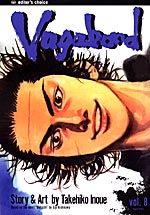 By Takehiko Inoue
By Takehiko Inoue
Based on the novel Musashi by Eiji Yoshikawa
216 pages, black and white
Published by Viz
When Viz first debuted Takehiko Inoue’s new series Vagabond two years ago, it’s safe to say that I loved it. Since then I’ve encountered Inoue’s earlier series Slam Dunk to much enjoyment, and I thought I’d learned what to expect from Inoue. With the new volume of Vagabond, though, Inoue has shown me that I still have much to learn.
Miyamoto Musashi’s haste almost cost him his life once before. That’s when he rushed into a battle with Inshun, the young master of the Hozoin Temple. Now he’s returned, calmer, for a second duel. What neither Musashi nor Inshun understand is that while they’re both eager to learn if they can win in a duel to the death, they’re each going to learn something far different about themselves.
In the previous volume of Vagabond, I was amazed at how tense Inoue could make a number of pages consisting solely of two men facing off, each preparing for the first strike. Inoue goes a step further here, as the battle finally explodes by moving the focus away from the lead character of Musashi and exploring Inshun’s past that lead him up to that moment. With so many creators, trying to suddenly insert the history of a supporting character would feel intrusive and silly, but here it slides into the narrative with the greatest of ease. Inshun’s history is gripping, and by the time it’s over the battle between him and Musashi speaks volumes about both of the characters. You’re able to see exactly why Inshun agreed to the duel, but just as importantly you recognize which parts of Inshun are reflected in Musashi’s life and how the two are both similar and different. At the same time, Inoue doesn’t forget to continue the story of Musashi’s old friend Matahashi, as his and Musashi’s past continues to catch up with them despite attempts to escape. What would be an annoying diversion in other books is tense and just as intriguing as the duel earlier in the book, with Inoue making sure the reader understands why this is important and menacing even at a distance. Inoue makes the writing of Vagabond to look immensely easy and effortless, even when the opposite may be true.
Inoue’s art is gorgeous as always. From the crosshatched shadows of night across the duelists’s faces to the powerful motions they make as they dance across the page towards each other, every panel is perfectly composed. I love how human Inoue’s characters look, from stringy pieces of hair sticking out at odd angles from their skull to the looks of terror in someone’s eyes as they understand that their moment of judgement has finally arrived. Inoue’s characters are drawn with broad, powerful lines, exuding a confidence as they face off against each other. At the same time, his backgrounds are drawn with such delicate and intricate lines that the contrast is startling. These are giants moving through the world that Inoue has created, and it’s a gorgeous overall look.
A friend recently told me that Vagabond is currently one of the hottest titles in Asia, and I believe him. An adaptation of Eiji Yoshikawa’s novel Musashi alone should be interesting, but Inoue’s skills as a comics creator makes Vagabond outstanding. This really is one of the best comics currently being produced. I buy every book as soon as it’s published, and once you take a look yourself, you’ll be doing the same.
Purchase Links:
